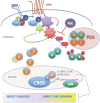Protein Kinase A and Anxiety-Related Behaviors: A Mini-Review
- PMID: 27445986
- PMCID: PMC4925668
- DOI: 10.3389/fendo.2016.00083
Protein Kinase A and Anxiety-Related Behaviors: A Mini-Review
Abstract
This review focuses on the anxiety related to cyclic AMP/protein kinase A (PKA) signaling pathway that regulates stress responses. PKA regulates an array of diverse signals that interact with various neurotransmitter systems associated with alertness, mood, and acute and social anxiety-like states. Recent mouse studies support the involvement of the PKA pathway in common neuropsychiatric disorders characterized by heightened activation of the amygdala. The amygdala is critical for adaptive responses leading to fear learning and aberrant fear memory and its heightened activation is widely thought to underpin various anxiety disorders. Stress-induced plasticity within the amygdala is involved in the transition from normal vigilance responses to emotional reactivity, fear over-generalization, and deficits in fear inhibition resulting in pathological anxiety and conditions, such as panic and depression. Human studies of PKA signaling defects also report an increased incidence of psychiatric disorders, including anxiety, depression, bipolar disorder, learning disorders, and attention deficit hyperactivity disorder. We speculate that the PKA system is uniquely suited for selective, molecularly targeted intervention that may be proven effective in anxiolytic therapy.
Keywords: anxiety; catalytic subunit; knockout mice; protein kinase A; regulatory subunit.
Figures
Similar articles
-
Activation of protein kinase A in the amygdala modulates anxiety-like behaviors in social defeat exposed mice.Mol Brain. 2016 Jan 8;9:3. doi: 10.1186/s13041-015-0181-3. Mol Brain. 2016. PMID: 26747511 Free PMC article.
-
Studies of mice with cyclic AMP-dependent protein kinase (PKA) defects reveal the critical role of PKA's catalytic subunits in anxiety.Behav Brain Res. 2016 Jul 1;307:1-10. doi: 10.1016/j.bbr.2016.03.001. Epub 2016 Mar 16. Behav Brain Res. 2016. PMID: 26992826 Free PMC article.
-
Disrupted Prediction Error Links Excessive Amygdala Activation to Excessive Fear.J Neurosci. 2016 Jan 13;36(2):385-95. doi: 10.1523/JNEUROSCI.3670-15.2016. J Neurosci. 2016. PMID: 26758831 Free PMC article.
-
[Neuroimaging and pathology in anxiety disorders, especially stress-induced fear circuitry disorders].Nihon Shinkei Seishin Yakurigaku Zasshi. 2010 Jun;30(3):135-9. Nihon Shinkei Seishin Yakurigaku Zasshi. 2010. PMID: 20666145 Review. Japanese.
-
The amygdala, panic disorder, and cardiovascular responses.Ann N Y Acad Sci. 2003 Apr;985:308-25. doi: 10.1111/j.1749-6632.2003.tb07090.x. Ann N Y Acad Sci. 2003. PMID: 12724167 Review.
Cited by
-
Activity of Protein Kinase A in the Frontal Cortex in Schizophrenia.Brain Sci. 2023 Dec 22;14(1):13. doi: 10.3390/brainsci14010013. Brain Sci. 2023. PMID: 38248228 Free PMC article.
-
Enrichment of Genomic Pathways Based on Differential DNA Methylation Associated With Chronic Postsurgical Pain and Anxiety in Children: A Prospective, Pilot Study.J Pain. 2019 Jul;20(7):771-785. doi: 10.1016/j.jpain.2018.12.008. Epub 2019 Jan 9. J Pain. 2019. PMID: 30639570 Free PMC article.
-
Asiaticoside produces an antidepressant‑like effect in a chronic unpredictable mild stress model of depression in mice, involving reversion of inflammation and the PKA/pCREB/BDNF signaling pathway.Mol Med Rep. 2020 Sep;22(3):2364-2372. doi: 10.3892/mmr.2020.11305. Epub 2020 Jul 6. Mol Med Rep. 2020. PMID: 32705202 Free PMC article.
-
Long-Term Impact of Diffuse Traumatic Brain Injury on Neuroinflammation and Catecholaminergic Signaling: Potential Relevance for Parkinson's Disease Risk.Molecules. 2024 Mar 26;29(7):1470. doi: 10.3390/molecules29071470. Molecules. 2024. PMID: 38611750 Free PMC article.
-
Inflammatory Pathogenesis of Post-stroke Depression.Aging Dis. 2024 Feb 9;16(1):209-38. doi: 10.14336/AD.2024.0203. Online ahead of print. Aging Dis. 2024. PMID: 38377025 Free PMC article. Review.
References
-
- Nesterova M, Bossis I, Wen F, Horvath A, Matyakhina L, Stratakis CA. An immortalized human cell line bearing a PRKAR1A-inactivating mutation: effects of overexpression of the wild-type Allele and other protein kinase A subunits. J Clin Endocrinol Metab (2008) 93:565–71.10.1210/jc.2007-1902 - DOI - PMC - PubMed
Publication types
Grants and funding
LinkOut - more resources
Full Text Sources
Other Literature Sources


